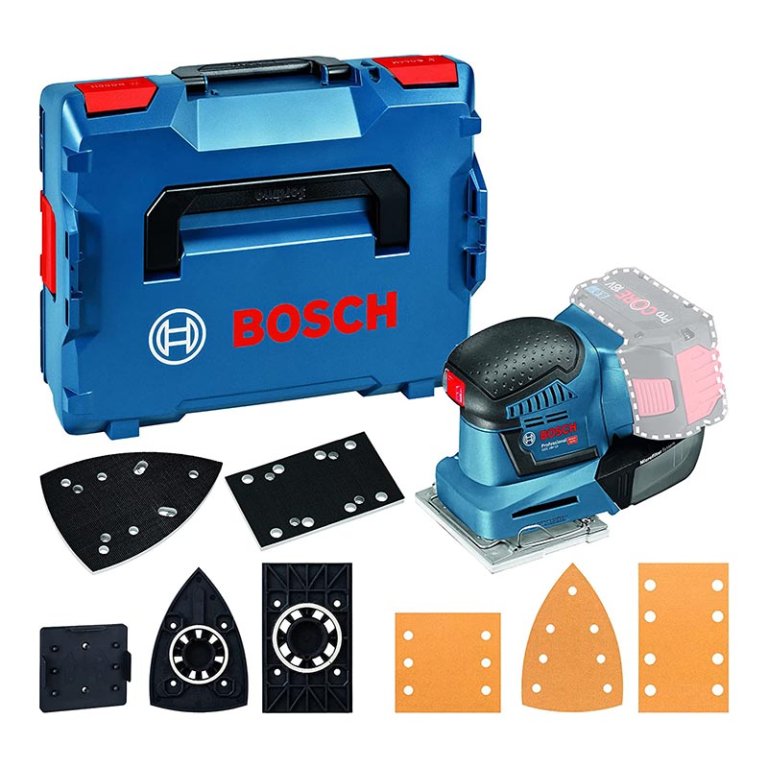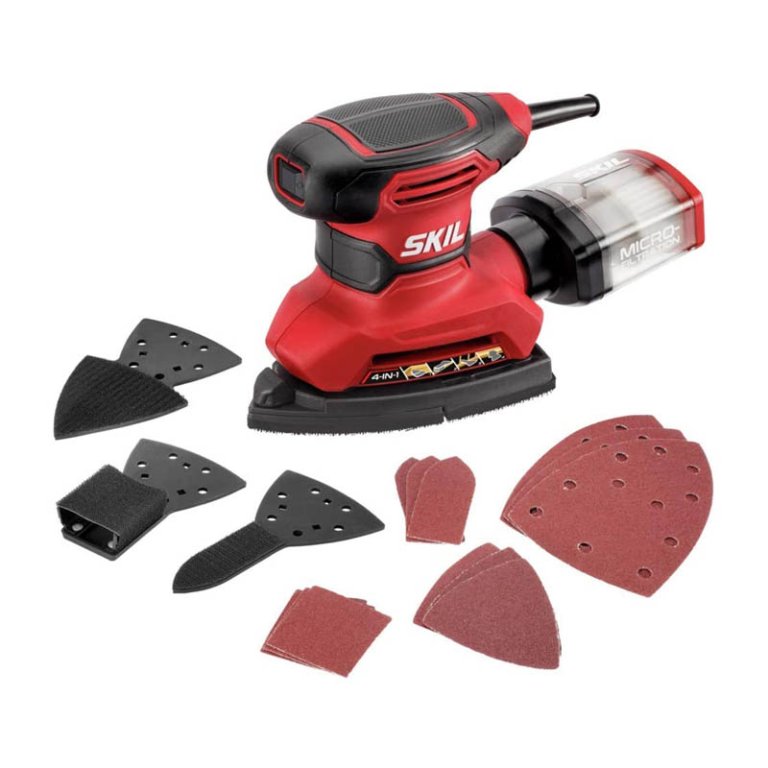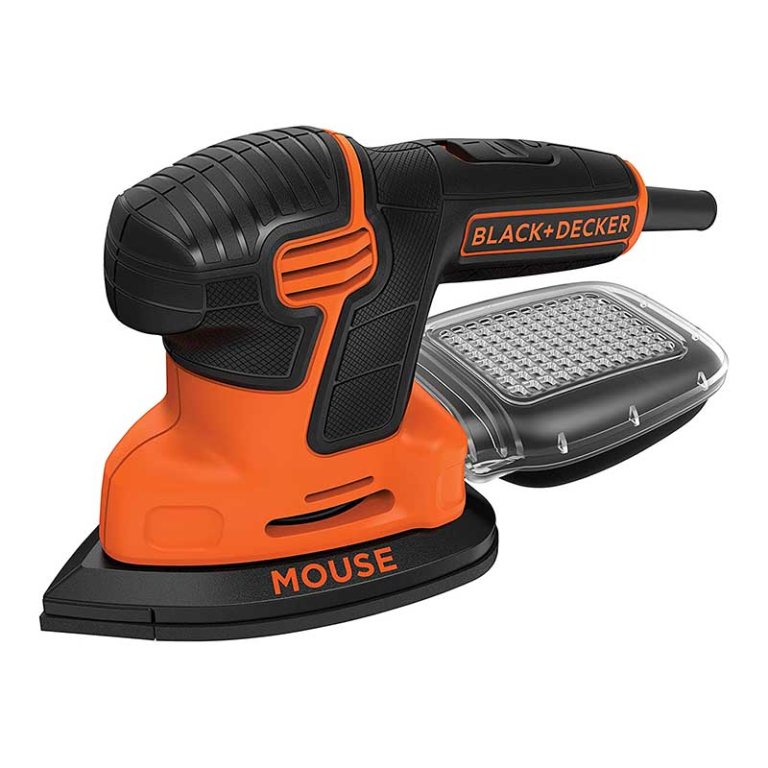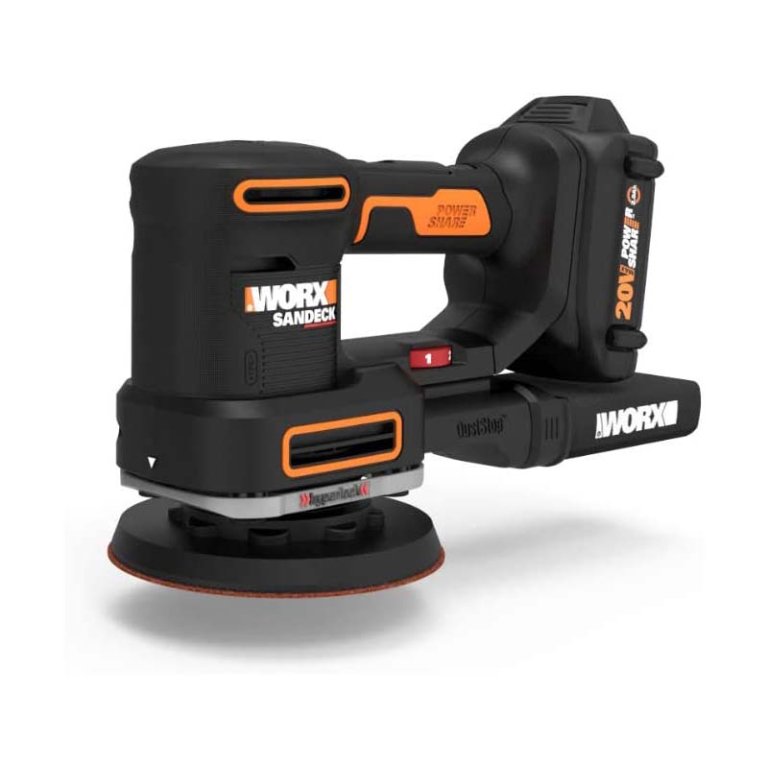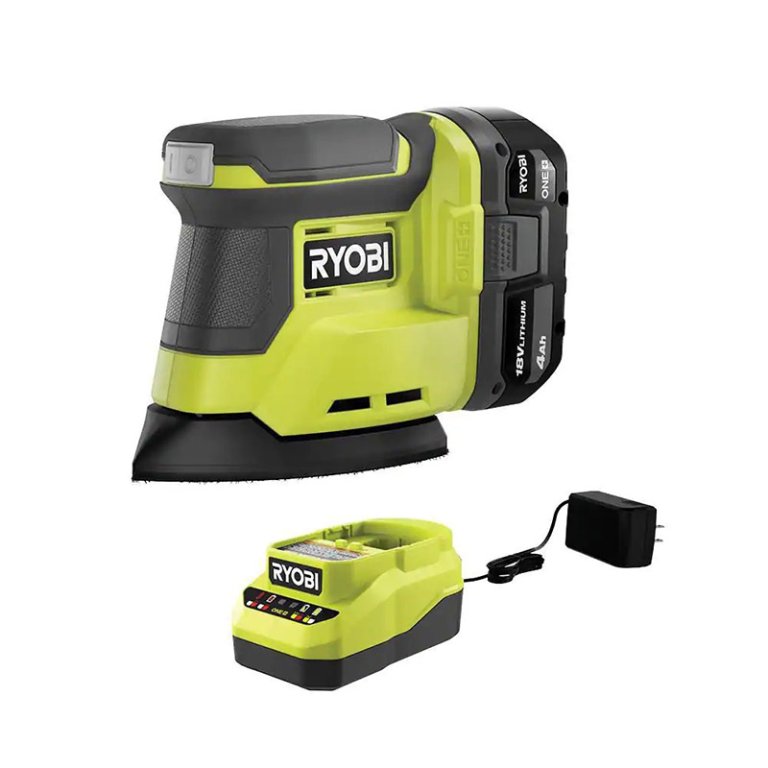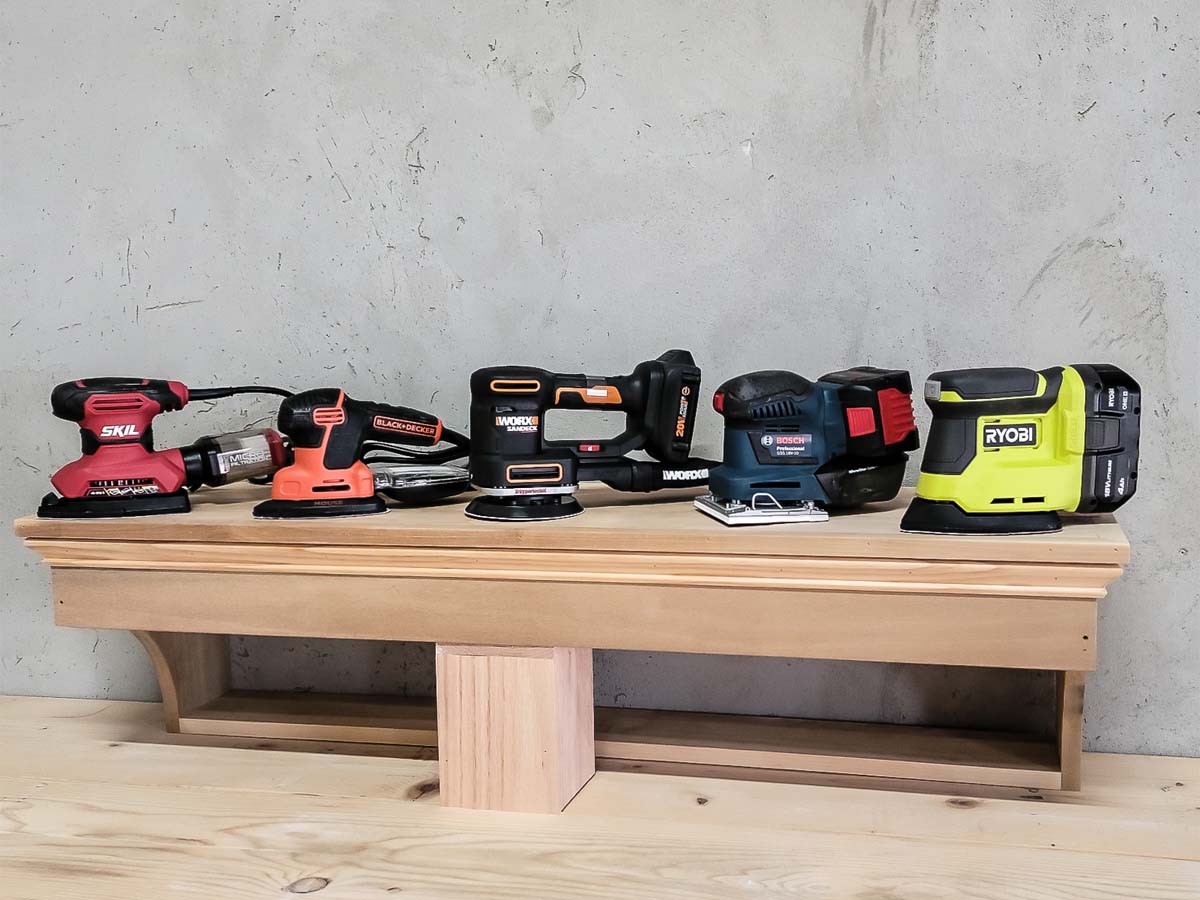
We may earn revenue from the products available on this page and participate in affiliate programs. Learn More ›
Whether you plan to paint or stain your wood project, you’ll almost certainly need to sand it to smooth the wood grain, reduce the risk of splinters, and give the item a nice sleek feel. Detail sanders work like other power sanders—they vibrate or move in an orbital motion (tiny circles) to quickly sand the surface. The only difference is that detail sanders are compact and designed for small sanding tasks. They allow the user to smooth the wood grain in tight spots and corners.
When used with finesse, detail sanders save time and reduce the risk of cross-grain marks, which can occur with hand sanding in corners and along edges. We wanted to know which of today’s best-selling detail sanders lived up to the marketing hype—so we tested them. We selected the top models and put them to work in our shop. We noted how well they smoothed the wood grain and how easy they were to use.
Sanding is one of those woodworking chores that’s hard to get excited about, but having a good detail sander can make the job more pleasant. Before buying, learn what to look for in one of these compact sanders and find out how the following models earned a spot on our lineup of the best detail sanders. Our favorite? The Bosch GSS thanks to its easy-to-use build and configurable setup.
- BEST OVERALL: Bosch GSS 18V-10 Cordless Orbital Sander L-Boxx 136
- BEST BANG FOR THE BUCK: Skil 1.2 Amp Multi-Sander SR232301
- BEST MOUSE SANDER: Black+Decker Mouse Detail Sander BDEMS600
- MOST VERSATILE: Worx 20V Power Share Sandeck 5-In-1 Multi-Sander
- BEST FOR CORNERS: Ryobi 18V One+ Corner Cat Finish Sander
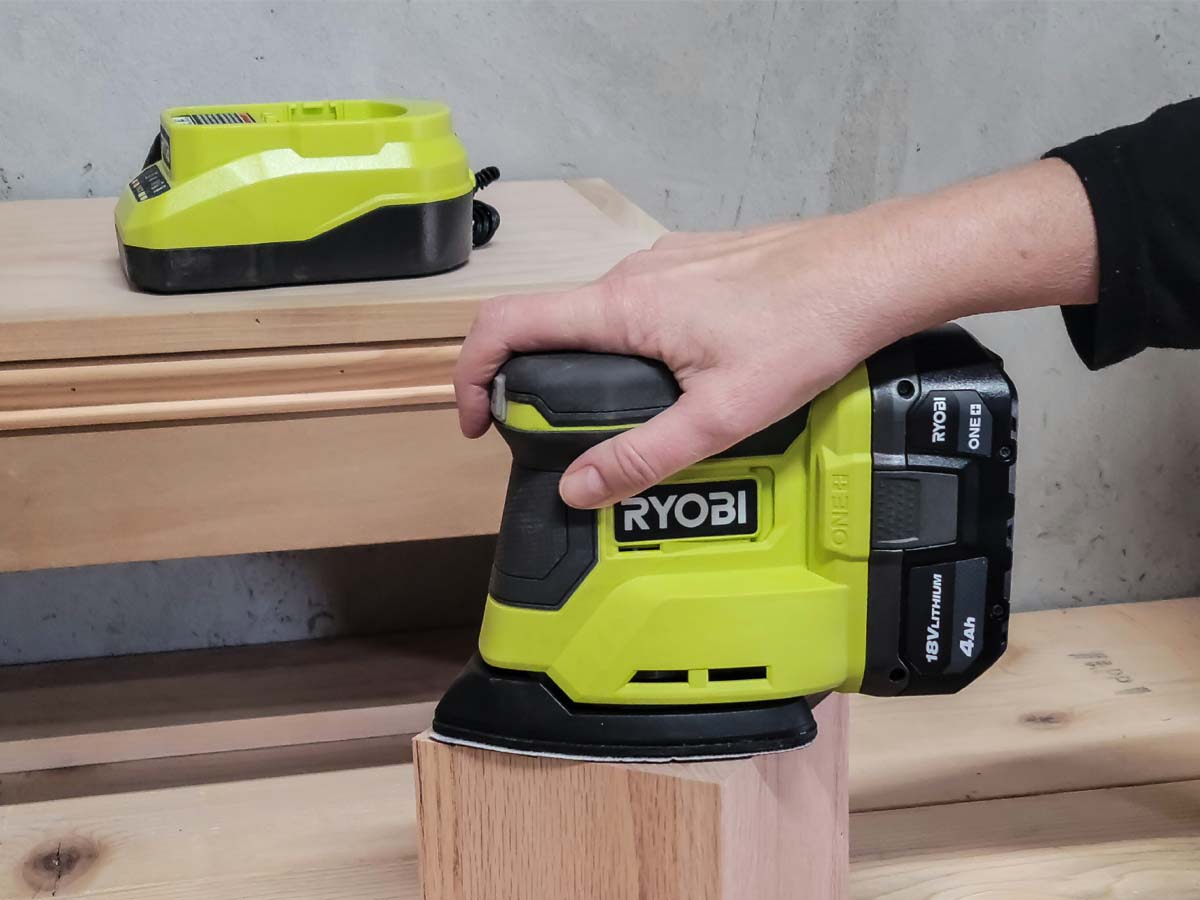
Detail Sanders Comparison
| Sander type | Power source | Weight | |
| Bosch GSS 18V-10 Cordless Orbital Sander L-Boxx 136 | Orbital | Rechargeable li-ion battery | 3.3 pounds |
| Skil 1.2 Amp Multi-Sander SR232301 | Orbital | Corded, electric | 2.6 pounds |
| Black+Decker Mouse Detail Sander BDEMS600 | Orbital | Corded, electric | 2.4 pounds |
| Worx 20V Power Share Sandeck 5-In-1 Multi-Sander | Random orbital | Rechargeable li-ion battery | 4.4 pounds |
| Ryobi 18V One+ Corner Cat Finish Sander | Orbital | Cordless, li-ion rechargeable battery | 1.54 pounds |
Our Top Picks
Large power sanders are typically too big and cumbersome to use in corners and narrow spots, so artisans and cabinet makers will turn to detail sanders to smooth the wood in those areas. The following detail sanders excelled in our hands-on tests for performance and ease of use. While they vary in features, accessories, and price, each is a top performer in its category. One is sure to be an excellent addition to your woodworking tool collection.
Best Overall
Bosch GSS 18V-10 Cordless Orbital Sander L-Boxx 136
See ItWhat We Like
- Snap-off dust catcher collects as much as 90 percent of sanding dust for cleaner air
- Easy on/off button on the front of the tool makes for simple operation
- 3 plate configurations allow users to select the right size and shape
What We Don’t Like
- Battery and charger must be purchased separately (any 18-volt Bosch battery will fit)
- Top grip is slightly awkward for controlling the sander with 1 hand
Product Specs
- Sander type: Orbital
- Power source: Rechargeable li-ion battery
- Weight: 3.3 pounds
We’re familiar with the high quality of Bosch tools, so we were excited to try out their compact 18-volt cordless orbital detail sander. We weren’t disappointed. This handy little sander comes with interchangeable sanding plates in three configurations—square, rectangular, and mouse (three-sided with a point, similar in shape to a clothing iron). Each plate has hook-and-loop (Velcro-type) sanding pads that stay firmly attached during operation.
We charged a Bosch 4-amp-hour (Ah) li-ion battery (battery and charger sold separately) and started testing. We attached the square plate to the sander using a screwdriver (included) and placed a square sanding pad on the plate. We tested the sander on both hardwood (oak and ash) and softwood (pine). The Bosch orbits at up to 22,000 orbits per minute (OPM). It made quick work of smoothing out the wood grain on all three types of wood.
We then switched to the mouse-shaped plate and pad and used the tip to sand along the grooves and edges of trim boards. The mouse plate makes the Bosch a cutting-edge detail sander because it allows users to sand in restricted spots. After sanding, we carefully checked the wood using a strong work light and didn’t detect any cross-grain scratches. We attribute the excellent results primarily to Bosch’s high OPM, but we also used light pressure when sanding. Firm pressure on a power sander is more likely to result in scratch marks.
A nice add-on is the onboard dust-collection system that features a removable dust box. Even when using the dust box, some sanding dust escaped into the air. However, we were impressed with how much was collected in the box. We estimated about 90 percent of the dust ended up in the dust box—that’s a lot of dust we avoided inhaling.
For us, a slight downside was the top grip, which felt a little wide and awkward. It wasn’t awful, but we thought the ergonomics could have benefitted from the sides being narrower, making it easier to grasp and control with one hand. Overall, the Bosch detail sander is excellent: It offers high OPMs, low vibration, and the dust catcher significantly reduces airborne dust.
Get the Bosch detail sander at Amazon or ToolNation (with battery and charger).
Best Bang for the Buck
Skil 1.2 Amp Multi-Sander SR232301
See ItWhat We Like
- Ergonomic, nonslip grip makes it easy to control the sander
- Hook-and-loop system holds sanding pads firmly on the plates
- Comes with attachments for sanding narrow spots and rails
What We Don’t Like
- Dust canister collects majority of sanding dust but about 20 percent still escapes
Product Specs
- Sander type: Orbital
- Power source: Corded, electric
- Weight: 2.6 pounds
With the Skil detail sander, users can sand along edges, in corners, and even on contoured rails without spending a lot. The corded sander boasts helpful accessories, including a thin sanding pad called a finger pad, a larger mouse pad, a small mouse pad, and a contour sanding attachment. We started testing with the large mouse sanding pad on hardwood and pine. It has a comfortable top grip that’s easy to grasp and control. The Skil features 13,500 OPM, which isn’t as fast as our Best Overall pick, but it’s decent and smoothed the wood grain quickly.
We did notice a few superficial cross-grain marks on the wood after sanding (when examined under very strong light), but overall the Skil did a great job. With just a couple of swipes of micro-grit sandpaper, we were able to buff out the marks—and woodworkers will typically want to finish up with a micro grit anyway for the smoothest finish.
We also tested the accessory plates, and we really liked the finger attachment that allowed us to sand between the back rails on a wooden rocking chair. We also appreciated the contour sanding accessory that allowed us to sand the round rails themselves. Round rails are one of the most time-consuming items to sand, so this is a nice add-on.
The Skil also comes with a micro-filtration system and a dust-collection canister. It didn’t collect as much sanding dust as we would have liked—we estimated it got about 80 percent—but that’s much better than no dust-collection canister at all.
The Skil detail sander is a great little shop tool for most sanding needs, and it comes at an attractive price point. Users may need to follow up with a light hand sanding with micro-grit sandpaper for a flawless sealed finish, but if the item will be painted, no additional sanding may be necessary.
Get the Skil detail sander at Amazon or Menards.
Best Mouse Sander
Black+Decker Mouse Detail Sander BDEMS600
See ItWhat We Like
- Traditional mouse-shaped sander for sanding along edges and in tight spots
- Comes with a dust-collection system to help reduce airborne sanding dust
- Features a narrow finger attachment for sanding narrow spots
What We Don’t Like
- Doesn’t collect all the sanding dust—about 20 percent escapes
- Extended grip is better suited to those with small hands
Product Specs
- Sander type: Orbital
- Power source: Corded, electric
- Weight: 2.4 pounds
Those looking for a compact mouse sander to get into tight spots need look no further than Black+Decker’s handy little detail sander that comes with a finger attachment for getting into the narrowest places. Plus, like many of the detail sanders we tested, the Black+Decker model has a built-in dust-collection system that we estimated collected about 80 percent of the sanding dust. The dust canister snaps off easily for dumping.
We started testing using the regular mouse sanding plate and one of the included hook-and-loop sanding pads. The sander made quick work of smoothing down the wood grain on both hardwood and pine, but we weren’t sold on the grip. While it can be grasped like a basic top grip, it also has an extended bar grip—a good idea, but the space between the grip and the dust canister is relatively narrow and not ideal for folks with large hands.
That point aside, the Black+Decker, which has an orbiting speed of 16,000 OPM, did a decent job of sanding without leaving cross-grain marks on flat boards. We next connected the detail finger attachment and used it to sand between chair rails. This task did leave a few light sanding marks but nothing that couldn’t be quickly smoothed out with a bit of micro-grit sanding paper.
Get the Black+Decker detail sander at Amazon or Menards.
Most Versatile
Worx 20V Power Share Sandeck 5-In-1 Multi-Sander
See ItWhat We Like
- Random orbital action for quick smoothing of wood grain without scratching
- Several attachments for versatile sanding projects and dust collection
- Comes with everything needed to get started right out of the box
What We Don’t Like
- Battery is on the low-capacity side at 2Ah
Product Specs
- Sander type: Random orbital
- Power source: Rechargeable li-ion battery
- Weight: 4.4 pounds
Worx may not be the best-known tool manufacturer in the country, but they knocked it out of the ballpark with this little sander. It has high-end options, including multiple sanding plates and accessories, an efficient dust-collection system, a battery, and a charger.
That’s not all—when we turned on the Worx sander, we felt a familiar gyroscopic movement that only occurs with a random orbital sander. In addition to its regular orbital action, the Worx sander incorporates a random motion that ensures the grit on the sandpaper doesn’t sand in the same place twice. The purpose of random orbital sanders is to further reduce the risk of sanding marks—and it worked very well. We found no cross-grain sanding marks after completing our flat-sanding tests.
We also tried out the accessories that came with the Worx sander, including a finger sanding attachment, a contour sanding attachment, a mouse plate, and a square plate. A nice feature of this sander is the ability to choose the sanding speed via a speed-adjustment dial. We liked that feature since different projects call for different sanding speeds.
The dust-collection system on the Worx is also versatile. It comes with a bag that collects what we estimated to be about 85 percent of the dust and can be connected to a shop-type vacuum. When we connected it to our vacuum, it collected about 95 percent of the dust. The trouble was the vacuum hose got in our way during testing.
The grip on the Worx sander is comfortable and well designed. It’s made to hold with one hand, and (if desired) a second hand can be placed on the top of the sander for added control.
We were impressed by the Worx sander’s quality and features but would have liked a higher-capacity battery. It comes with a 2Ah rechargeable battery, but anyone who needs to do a lot of sanding may wish to invest in a more powerful battery that won’t run out of juice quickly.
Get the Worx detail sander at Amazon or Lowe’s.
Best for Corners
Ryobi 18V One+ Corner Cat Finish Sander
See ItWhat We Like
- Lightweight and ergonomically designed to minimize hand and wrist fatigue
- Comes with a high-efficiency 4Ah battery and charger
- Compact size for reaching into tight spaces and restricted spots
What We Don’t Like
- No onboard dust-collection system; adapter for a vacuum sells separately
Product Specs
- Sander type: Orbital
- Power source: Cordless, li-ion rechargeable battery
- Weight: 1.54 pounds
Ryobi, one of The Home Depot’s flagship brands, has created a compact cordless sander that’s well suited to sanding in corners or along edges. This handy little detail sander comes with a high-capacity 4Ah rechargeable battery and a charger, and we found it a joy to use.
It lacks a self-contained dust-collection system, which is a downside, but it does have a slot on the side where we could have hooked our shop vacuum hose if we’d had the dust-port attachment, which, unfortunately, is sold separately. We toughed it out and wore our dust masks because the sander generated a good deal of dust.
It only has a triangular mouse base, but we feel that’s the most commonly used base in a detail sander. The ergonomic grip sits directly above the sanding plate, which offers maximum control. In testing, the Ryobi Cat finish sander quickly removed rough wood grain and left the surface smooth to the touch. It was easy to use and had minimal vibration, so we could sand longer without experiencing hand and wrist fatigue.
This orbital sander produces 11,000 OPM, and we found only a couple of very fine cross-grain marks that were only visible under a strong work light. We were able to sand efficiently in corners and along edges smoothly. This compact sander weighs in at just 1.54 pounds without the battery, making it one of the lightest models we tested, yet it does an excellent job of quickly smoothing out rough wood.
Get the Ryobi detail sander at The Home Depot.
Jump to Our Top Picks
How We Tested the Best Detail Sanders
In choosing the tools for testing, we extensively researched more than 20 compact power sanders, paying close attention to which ones were highly rated by professional woodworkers and DIYers. We considered brand reputation—manufacturers like Bosch are well known for producing top-notch power tools—but we didn’t eliminate smaller companies if the devices were quality made and offered functions we considered important.
In our hands-on testing, we used each tool to sand various types of hardwood and pine. We noted how well they smoothed the wood grain and whether they left any sanding marks. We awarded points based on a rubric—the better a sander performed a specific function, the more points it received. We also awarded points for ergonomic design, helpful features like dust-collection systems, and overall power.
After testing, we added and averaged the points for each model and used the final figures to help determine our top picks and the best categories for each sander.
What to Consider When Choosing the Best Detail Sander
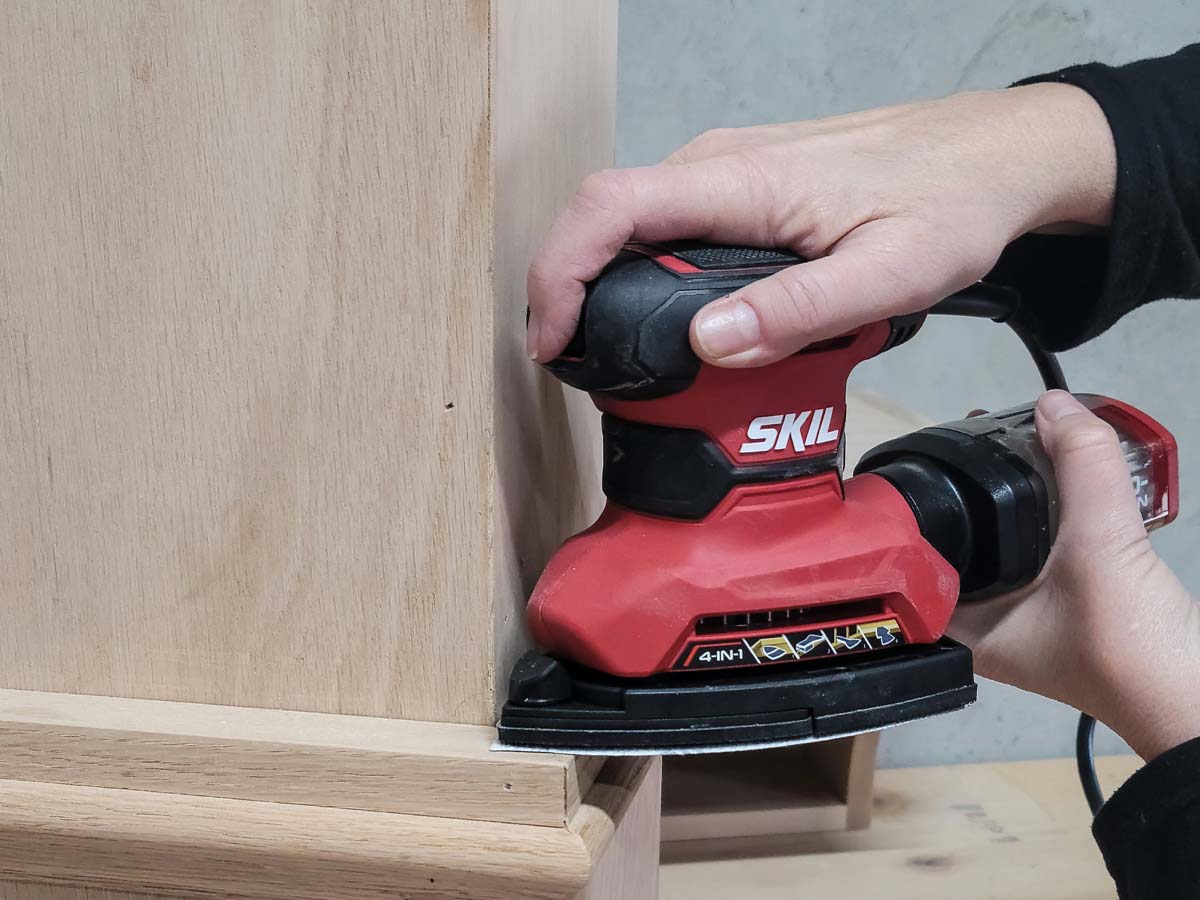
When searching for the best detail sander to help tackle a woodworking project, consider whether a cordless or corded model would be best. Additional factors to keep in mind include battery power (for cordless models) and the availability of a dust-collection system. Plus, don’t forget about ergonomics—many of today’s top detail sanders come with padded, nonslip grips designed to minimize vibration.
Intended Use
One of the most common sanding base configurations found on a detail sander is mouse shaped. The wide area of the mouse sanding pad is suitable for sanding large flat sections of wood, while the tip of the pad is best suited for sanding in corners or along narrow edges. Many models come with attachments that offer specialized sanding, such as sanding fingers that can be used in limited spots like between chair rails, or contour sanding pads that allow the user to smooth cylindrical shapes—such as the rails themselves.
Most of today’s top detail sanders also come with dust-collection systems to reduce airborne sanding dust via an onboard collection canister or a port that attaches to the user’s shop-type vacuum for dust collection.
Power
Detail sanders are either corded or cordless. There are drawbacks and benefits to both types.
- Corded detail sanders require a power cord. These devices generally have a higher power output than cordless sanders, though they are limited by the length of the cord. The tool can be plugged into a heavy-duty extension cord to gain more freedom to move around, but an available power outlet is still necessary.
- Cordless detail sanders rely on a rechargeable battery to power the sanding pad, though they cannot usually produce the same power output as a corded sander. However, users needn’t to worry about tripping over a cord or getting the cable tangled up while trying to work. Power capacity is determined by the battery’s amp hours, and most users will want a minimum of 3Ah to 4Ah batteries to keep from having to recharge frequently.
Speed
The speed of the detail sander is a crucial factor to consider. Speed for a detail sander refers to orbital velocity, the number of times the sanding pad moves in tiny circles in 1 minute. This speed is measured in OPM. The higher the OPM rate of the detail sander, the more effective it is at removing rough wood.
However, very high speeds can be counterproductive for some woodworking projects because an inexperienced user can grind away too much material in just a few seconds. Detail sanders can range in speed from around 10,000 to 25,000 OPM.
Runtime
If the versatility and maneuverability of a cordless detail sander seem more appealing than dealing with a power cord, the runtime should factor into the purchasing decision. Runtime refers to the time the sander can operate on a full battery charge. However, this doesn’t consider the type of wood, the age of the battery, or the user’s experience.
Dense materials, like robust hardwood, will require more energy to get the desired results, and they can wear down the battery faster than softer materials. Similarly, an inexperienced user may push too hard on the sander, causing it to draw more power from the battery than necessary. The more often the battery is used and recharged, the shorter the runtime until it becomes a better idea just to replace the battery.
Ease of Use
When shoppers are deciding on the best detail sander for their next project, a few factors, including weight, vibration, and design, can make the tool easier or more challenging to use. Typically, a detail sander weighs between 1 and 4 pounds.
Detail sanders operate at high speeds between 10,000 to 25,000 OPM, which can produce significant vibration. To save hands from muscle fatigue and strain, look for a sander with ergonomic handles coated in vibration-dampening padding. The extra padding will reduce the sander’s tendency to vibrate, making the work easier on hands.
Additional Features
After deciding on the speed, power, runtime, and use, it’s time to look for attractive additional features like pressure detection, dust collection, accessories, and safety features.
- Dust-collection systems incorporate a fan into the detail sander, allowing it to suck up any dust created. This system may include a dust-collection compartment or bag, but some models require a separate system or vacuum.
- Accessories can include additional sandpaper, detail sanding attachments, sander blades, accessories cases, and carrying cases.
- Safety features for detail sanders focus mostly on reducing muscle strain and fatigue through vibration-dampening padding. However, some products also may have built-in lights to help users see in dim lighting conditions.
Versatility
Detail sanders have a compact shape and a triangular sanding pad so they can access hard-to-reach locations on woodworking projects like corners, edges, and odd angles. However, these devices also can include detail-sanding attachments to account for narrow spaces, like the gap between the spindles of a wood chair’s backrest.
Some tools can switch out the sanding pad for a cutting blade, allowing them to be used for a wide range of tasks, including cutting, grinding, scraping, and grout removal. If this type of multifunction detail sander seems appealing, look for a tool with a complete kit and a carrying bag to keep the accessories safe and organized when not in use.
FAQs
Sand, smooth, shape, and finish fine furniture, doors, and more with a detail sander. If you aren’t entirely sure how to use a detail sander or what grit of sandpaper would be best, take a look at the answers below to some commonly asked questions about these tools.
A detail sander can be used on various woodworking projects, like refinishing a door, table, cabinet, or dresser. The purpose of this type of sander is to sand corners, tight spaces, and any detailed patterns or designs in the wood.
To use a detail sander, first equip it with a piece of sandpaper and then connect the battery or power cord. Turn on the sander before placing it on the wood. Avoid forcing the sander down into the wood; instead, take it slow and allow the detail sander to remove the top layer of material to expose a smooth surface.
Sandpaper is organized by grit. Sandpaper with lower numbers like 40 to 50 grit indicates coarse sandpaper, while high numbers begin at about 120 grit and exceed 220 grit. These higher numbers signify fine or extra-fine sandpaper. Coarse sandpaper is used to remove a lot of material quickly, but it can leave some roughness behind. Fine sandpaper doesn’t remove much material, but the finish is soft and smooth. Choose the sandpaper that best suits your goals.
If sandpaper won’t stick to your detail sander, the sander pad likely needs to be cleaned or replaced. If the pad is damaged or worn out, it must be replaced.
Meet the Tester
Glenda Taylor is a product tester and writer specializing in construction, remodeling, and real estate. She and her husband own a general contracting company, and she is experienced in both residential and commercial building applications. She tests a wide range of power tools as well as other home improvement, household, and lawn-and-garden products.
Additional research provided by Timothy Dale.



